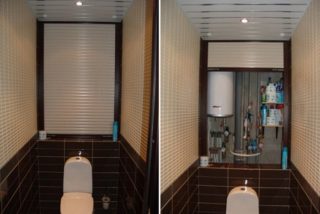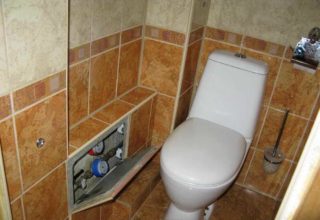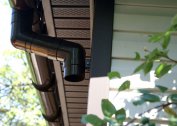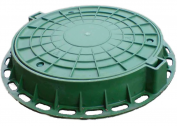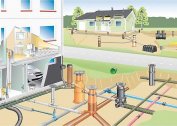The wiring of water supply and sanitation is located in the bathrooms and toilets. During a major overhaul, the owner considers the options: hide the risers and pipes behind the decorative panels or leave everything as is to ensure free access in case of an unexpected repair. Overhaul is not a good option, as it will not allow replacing fittings or repairing in the future. The solution lies in disguising plumbing communications.
How to close a sewer in a toilet
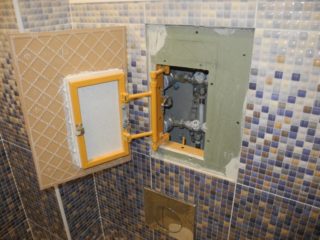
The interior of the bathroom can be transformed by plasterboard plates. They are 93% composed of gypsum mixture and 6% construction paper, so the material has several advantages:
- lack of toxic substances;
- a light weight;
- simple installation;
- low cost;
- finishing finished parts in any way;
- amenable to tooling.
Drywall is used to install partitions, arches, shelves, false ceilings. Choose moisture resistant cardboard panels. The material is more durable than plastic products, but its installation has its own nuances: it is necessary to cut and fit the elements, hiding the fasteners. For the final finish, they are lined with ceramic plates.
PVC products are more decorative than plasterboard sheets. In addition, they are waterproof, resistant to temperature extremes and do not require additional finishing. Sheets have a different texture and a large palette of color shades. Their cost is low.
The sewer pipe in the toilet can be closed using boxes made of PVC panels and drywall. First they make a frame on which ready-made elements are mounted. Drywall needs additional coating, for this the sheets are painted or decorated with tiles.
It is convenient to close communications in the closet. The presence of doors allows you to revise pipes at any time, take readings of hot and cold water meters. Shelves will allow you to ergonomically use the bathroom, carefully hiding various household items and laundry detergents. You can buy a ready-made furniture facade or order in firms involved in the interior of bathrooms.
To provide access to water meters without complicated window installation, only the lower part of the duct is paneled, instead of doors, roller shutters or shutters are installed in the upper part. The movable structure has a frame and a roll of untwisting panels at the base. Button or remote control quickly opens access to communications. The material from which the shutters are made is waterproof, so they can be used in rooms with high humidity.
Finished sliding panels do not require finishing, usually decorated with decorative elements or patterns.
Budget option - plumbing blinds. The device does not have a frame and is controlled manually. Resistant to moisture. Their lack of low strength and unreliability.
With a little imagination, you can mask the pipes using various elements using the decoupage technique. It is enough to paint them with a suitable color paint and apply patterns. You can wrap the pipes with some fibrous material, for example, twine, attach artificial green twigs or wall stickers.
The choice of material for masking pipes
The specifics of bathrooms in high humidity rooms.Therefore, finishing materials must meet certain requirements:
- have good moisture resistance;
- to be compact;
- provide easy installation.
Reliable designs become a barrier to sewer odors. The frame is made of wooden bars or galvanized steel corners. Wooden parts are pre-treated with antiseptics. The plasterboard, PVC and MDF panels cover the communications.
Of all the proposed options, the smallest investments will require PVC sheets and blinds. A box of drywall will need to be trimmed with decorative tiles or painted. The purchase of a facade for a plumbing cabinet or rolling shutters will cost more.
Plastic panels are quite fragile, but with a careful attitude they will last quite a long time, in addition, they can be easily replaced.
What to do before installation
Overhaul of sanitary units should begin after the audit of communications:
- replace the rusted old pipes and seal the holes in the ceilings with mounting foam;
- make sure that the sewage system is working;
- eliminate leaks by applying sealant to the joints of the joints;
- clean the workplace from dust and debris.
If the pipes are in order and do not require replacement in the near future, you can start decorating the premises by installing the frame of the box around the risers and wiring. Then a strip is attached, relative to which the panels are sewn, fixing each element with stapler brackets or studs. Intermediate slats are attached to the frame so that the installation of the panels is more reliable.
The main ways to seal the pipeline in the toilet
To install masking roller shutters, a false wall is mounted:
- Mark out for future fixing of the bars. The depth of the hidden part of the room should ensure the free concealment of all plumbing elements.
- Attach guide profiles with marking dowels.
- Secure guide rails 50 mm from intermediate profiles.
- Perform sewing with drywall using self-tapping screws.
- Make holes for the door with a cutter.
The cost of moisture-proof drywall with sheet sizes of 3000 * 1200 * 12.5 mm is about 350 rubles. Metal profiles can be guides and wall. The first are used to make the contour of the box and are mounted in the corners. Wall ones serve to strengthen the strength of the structure if its height exceeds 1000 mm. From above, the box is disguised as the interior of the toilet room, for this it is covered with decorative tiles.
The box for the sewer pipe in the toilet is used if the communications are concentrated in one corner. The installation differs from the first option in size and dimensions. For the frame, a bar of 40 * 40 size is selected. Overhaul will not allow to clean the sewer through revisions.
If the wiring comes out in several places, from the bottom and in the middle, it is closed with the help of multi-level boxes that look more aesthetic than individual protruding elements.
Material for the manufacture of a sanitary cabinet can be moisture-proof drywall, laminated or edged boards. For the frame, wooden bars are used, the surface under the facade part is sheathed with plywood. Doors can be both oar and sliding.
